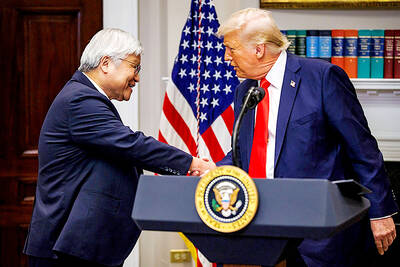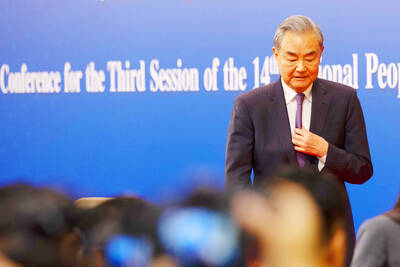The UN Security Council was yesterday to vote on a new draft resolution calling for an immediate ceasefire in Gaza, despite threat of a third US veto on such a text.
The document, prepared by Algeria, “demands an immediate humanitarian ceasefire that must be respected by all parties.”
The vote comes as Israel prepares to move into the southern Gaza Strip city of Rafah, where about 1.4 million people have fled, as part of its mission to destroy Hamas.

Photo: Reuters
However, it is facing increased pressure to hold off, including from its closest ally, the US.
The draft resolution opposes the “forced displacement of the Palestinian civilian population.”
It also demands the release of all Hamas hostages.
Similarly to other previous drafts spurned by the US and Israel, the new text does not condemn Hamas’ Oct. 7 assault. That attack left about 1,160 people dead in southern Israel, mostly civilians, according to an Agence France-Presse tally of official Israeli figures.
Israel’s retaliatory campaign has killed more than 29,000 people in Gaza, mostly women and children, according to the latest count by the Hamas-run territory’s health ministry.
The US warned over the weekend that Algeria’s text was not acceptable, threatening to veto it.
“We don’t believe that this council product will help the situation on the ground,” US Deputy Ambassador to the UN Robert Wood said on Monday. “If this resolution does come to a vote, it will not go forward.”
The passage of such a ceasefire resolution would endanger ongoing delicate diplomatic negotiations, which could see the release of hostages from Gaza, Wood said.
The US instead began circulating an alternate draft on Monday. While that text does include the word “ceasefire” — which the US has previously avoided, vetoing two drafts in October and December which used the term — it does not call for the end of hostilities to happen immediately.
Echoing recent comments by US President Joe Biden, the US draft supports a “temporary ceasefire in Gaza as soon as practicable, based on the formula of all hostages being released.”
It also mentions concern for Rafah, stating that “a major ground offensive should not proceed under current circumstances.”
There is no “deadline” for a vote on the US draft, a senior US official said, adding that there would be no “rush.”
However, even if there is no hurry, the US text “as it is ... cannot pass,” one diplomatic source said, citing several issues around the phrasing of “ceasefire” and the risk that any text introduced to the 15-member body by the US might face a veto from Russia.
In any case, the mere fact the US has introduced a counter-resolution is likely to “make Israel nervous,” International Crisis Group analyst Richard Gowan said.
“The US is finally using the Security Council as a platform to signal the limits of its patience with the Israeli campaign,” Gowan said.
Despite the specter of a US veto, Permanent Observer of Palestine to the UN Riyad Mansour had insisted on a vote days ago, saying that the Arab Group had been “more than generous to give our colleagues additional time.”

CRITICAL MOVE: TSMC’s plan to invest another US$100 billion in US chipmaking would boost Taiwan’s competitive edge in the global market, the premier said The government would ensure that the most advanced chipmaking technology stays in Taiwan while assisting Taiwan Semiconductor Manufacturing Co (TSMC, 台積電) in investing overseas, the Presidential Office said yesterday. The statement follows a joint announcement by the world’s largest contract chipmaker and US President Donald Trump on Monday that TSMC would invest an additional US$100 billion over the next four years to expand its semiconductor manufacturing operations in the US, which would include construction of three new chip fabrication plants, two advanced packaging facilities, and a research and development center. The government knew about the deal in advance and would assist, Presidential

‘DANGEROUS GAME’: Legislative Yuan budget cuts have already become a point of discussion for Democrats and Republicans in Washington, Elbridge Colby said Taiwan’s fall to China “would be a disaster for American interests” and Taipei must raise defense spending to deter Beijing, US President Donald Trump’s pick to lead Pentagon policy, Elbridge Colby, said on Tuesday during his US Senate confirmation hearing. The nominee for US undersecretary of defense for policy told the Armed Services Committee that Washington needs to motivate Taiwan to avoid a conflict with China and that he is “profoundly disturbed” about its perceived reluctance to raise defense spending closer to 10 percent of GDP. Colby, a China hawk who also served in the Pentagon in Trump’s first team,

SEPARATE: The MAC rebutted Beijing’s claim that Taiwan is China’s province, asserting that UN Resolution 2758 neither mentions Taiwan nor grants the PRC authority over it The “status quo” of democratic Taiwan and autocratic China not belonging to each other has long been recognized by the international community, the Mainland Affairs Council (MAC) said yesterday in its rebuttal of Beijing’s claim that Taiwan can only be represented in the UN as “Taiwan, Province of China.” Chinese Minister of Foreign Affairs Wang Yi (王毅) yesterday at a news conference of the third session at the 14th National People’s Congress said that Taiwan can only be referred to as “Taiwan, Province of China” at the UN. Taiwan is an inseparable part of Chinese territory, which is not only history but

INVESTMENT WATCH: The US activity would not affect the firm’s investment in Taiwan, where 11 production lines would likely be completed this year, C.C. Wei said Investments by Taiwan Semiconductor Manufacturing Co (TSMC, 台積電) in the US should not be a cause for concern, but rather seen as the moment that the company and Taiwan stepped into the global spotlight, President William Lai (賴清德) told a news conference at the Presidential Office in Taipei yesterday alongside TSMC chairman and chief executive officer C.C. Wei (魏哲家). Wei and US President Donald Trump in Washington on Monday announced plans to invest US$100 billion in the US to build three advanced foundries, two packaging plants, and a research and development center, after Trump threatened to slap tariffs on chips made